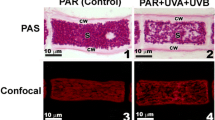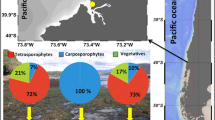Abstract
The snow alga Chlamydomonas nivalis was collected from the Sierra Nevada, California, USA, and examined for its ability to produce phenolic compounds, free proline, and provide antioxidant protection factor in response to UV-A and UV-C light. Exposure of C. nivalis cells to UV-A light (365nm) for 5 days resulted in a 5–12% increase in total phenolics, where as exposure to UV-C light (254 nm) resulted in a 12–24% increase in phenolics after 7 days of exposure. Free proline was not affected by UV-A, but increased markedly after UV-C exposure. A three-fold increase in free proline occurred within two days after exposure to UV-C, but then dropped as cells became bleached. Antioxidant protection factor (PF) increased after treatment of cells with UV-A and remained constant throughout UV-C exposure. Spectral analysis of algal extracts revealed a decrease in absorption in the 215–225 nm region, short-term (2day) stimulation of pigment at 280 nm, and an increase in carotenoids (473 nm), after exposure to UV-A. Snow alga exposed to UV-C light had a different spectrum from that of UV-A exposed cells, i.e. an enhancement of three major peaks at 220, 260, and 280 nm, and loss of absorption in the carotenoid region.We report that UV light exposure, especially in the UV-C range, can stimulate phenolic-antioxidant production in aplanospores of C. nivalis effecting biochemical pathways related to proline metabolism.
Similar content being viewed by others
References
Alia PSP (1993) Suppression in mitochondrial electron transport is the prime cause behind stress induced proline accumulation. Biophys. Res. Commun. 193: 54–58.
Alia PSP, Mohanty P (1991) Proline enhances primary photochemical activities in isolated thylakoid membranes of Brassica juncea by arresting photoinhibitory damage. Biochem. biophys. Res. Commun. 181: 1238–1244.
Andarwulan N, Shetty K (1999) Phenolic content in differentiated tissue cultures of untransformed and Agrobacterium-transformed roots of anise (Pimpinella anisum L.). J. agric. Food Chem 47: 1776–1780.
Ballare CL, Barnes PW, Flint SD, Price S (1995) Inhibition of hypocotyl elongation by ultraviolet-B radiation in de-etiolating tomato seedlings. II. Time-course, comparison, with flavonoid responses and adaptive significance. Physiol. Plant. 93: 593–601.
Balzer I, Hardeland R (1996) Melatonin in algae and higher plantspossible new roles as a phytohormones and antioxidant. Botanica Acuta 109: 180–183.
Bidigare RR, Ondrusek ME, Kennicutt MC, Iturriaga R, Harvey HR, Hoham RW, Macko SA (1993) Evidence for a protective function for secondary catotenoids of snow algae. J. Phycol. 29: 427–434.
Blunden G (1993) Marine algae as sources of biologically active compounds. Interdiscip. Sci. Rev. 18: 73–80.
Brown MR (1991) The amino acid and sugar composition of 16 species of microalgae used in mariculture. J. exp. mar. Biol. Ecol. 145: 79–99.
Campos JL, Figueras X, Pinol MT, Boronat A, Tiburcio AF (1991) Carotenoid and conjugated polyamine levels as indicators of ultraviolet-C induced stress in Arabidopsis thaliana. Photochem. Photobiol. 53: 689–693.
Chandler SF, Dodds JH (1983) The effect of phosphate, nitrogen and sucrose on the production of phenolics and solasidine in callus cultures of Solanum laciniatum. Plant Cell Rep. 2: 105.
Chavan UD, Amarowicz R, Shahidi F (1999) Antioxidant activity and phenolic fractions of beach pea (Lathyrus maritimus L.). J. Food Lipids. 6: 1–11.
Duval B, Duval E, Hoham RW (1999) Snow algae of the Sierra Nevada, Spain, and the High Atlas Mountains of Morocco. Microbiol. Intl. 2: 39–42.
Floss HG (1997) Natural products derived from unusual variants of the shikimate pathway. Natural Prod. Rep. 14: 433–452.
Foti M, Piattelli M, Amico V, Ruberto G (1994) Antioxidant activity of phenolic meroditerpenoids from marine algae. J. Photochem. Photobiol. 26: 159–164.
Fritzemeier K-H, Rolfs C-H, Pfau J, Kindi, H (1983) Action of ultraviolet-C on stilbene formation in callus of Arachis hypogaea. Planta. 159: 25–29.
Gerber S, Häder D-P (1994) Effects of enhanced UV-B irradiation on the red coloured freshwater flagellate Euglena sanguinea. FEMS Microbiol. Ecol. 13: 177–184.
Gerwick WH, Roberts MA, Proteau JP, Chen J-L (1994) Screening cultured marine microalgae for anticancer-type activity. J. appl. Phycol. 6: 143–149.
Hare PD, Cress WA (1997) Metabolic implications of stress-induced proline accumulation in plants. Plant Growth Regul. 21: 79–102.
Hoham RW, Duval B (2000) Microbial ecology of snow and fresh-water ice with emphasis on snow algae. In Jones HG, Pomeroy JW, Walker DA, Hoham RW (eds), Snow Ecology: An Interdisciplinary Examination of Snow-Covered Ecosystems. Cambridge Univ. Press, Cambridge, UK (in press).
Hoppe H, (1982) Marine algae: their products and constituents. In Hoppe H, Lovring T (eds), Marine Algae in Pharmaceutical Science. Vol 2. Walter de Gruyter, Berlin, pp. 3–48.
Huang M-T, Farraro T (1992) Phenolic compounds in food and cancer prevention. In Huang M-T, Ho C-T, Lee CY (eds), Phenolic compounds in food and their effects on health II, antioxidants and cancer prevention. Chap 2. ACS Sym 507: 8–33.
Jorgensen LV, Madsen HL, Thomsen MK, Dragsted LO, Skibsted LH (1999) Regulation of phenolic antioxidants from phenoxyl radicals: An ESR and electrochemical study of antioxidant hierarchy. Free Radical Res. 30: 207–220.
Kol E (1968) Kryobiologie. Biologie und Limnologie des Schnees und Eises. I. Kryovegetation. In Elster HJ, Ohle W (eds), Die Binnengewasser, E. Schweizerbart'sche Verlagsbuchhandlung, Stuttgart: 216 pp.
König GM, Wright AD (1993) Algal secondary metabolites and their pharmaceutical potential. In Kinghorn AD, Balandrin MF (eds), Human medicinal agents from plants. ACS Washington D.C., pp. 276–293.
Kozak RG, Ricco RA, Gurni AA, Boveris AD, Puntarulo S (1999) Antioxidant response of soybean cotyledons (Glycine max) to ultraviolet irradiation. Can. J. Plant Sci. 79: 181–189.
Kwok D, Shetty K (1997) Effects of proline and proline analogs on total phenolic and rosmarinic acid levels in shoot clones of thyme (Thymus vulgaris L). J. Food Biochem. 22: 37–51.
Liu L, Gitz DC, McClure JW (1995) Effects of UV-B on flavonoids, ferulic acid, growth and photosynthesis in barley primary leaves. Physiol. Plant. 93: 725–733.
Lohrenz SE, Taylor CD (1987) Inorganic 14C as a probe of growth rate-dependent variations in intracellular free amino acid and protein composition of NH4-limited continuous cultures of Nannochloris atomis B. J. Exp. Mar. Biol. Ecol. 106: 31–55.
Malanga G, Puntarulo S (1995) Oxidative stress and antioxidant content in Chlorella vulgaris after exposure to ultraiolet-B radiation. Physiol. Planta. 94: 672–679.
Marchant HJ (1998) Life in the snow: algae and other microorganisms. In Green K (ed.), Snow: A Natural History; an Uncertain Future. Australian Alps Liaison Committee, Canberra, Australia. Chap. 5, pp. 83–97.
Margalith PZ (1992) Pigment Microbiology. Chapman and Hall, London, 156 pp.
Müller T, Bleiß W, Rogaschewski MS, Fuhr G (1998) Snow algae from northwest Svalbard: their identification, distribution, pigment and nutrient content. Polar Biol. 20: 14–32.
Paganga G, Miller N, Rice-Evans CA (1999) The polyphenolic content of fruit and vegetables and their antioxidant activities. What does a serving constitute? Free Radical Res. 30: 153–162.
Pardha SP, Alia AS, Prasad KV (1995) Proline accumulates in plants exposed to UV radiation and protects them against UV induced peroxidation. Biochem. Biophys. Res. Commun. 209: 1–5.
Piacentini MP, Ricci D, Fraternale D, Piatti E, Manunta A, Accorsi A (1999) Effects of UV-C irradiation on phosphoinositide turnover in plant cells: similarities with those occurring via the formation of reactive oxygen intermediates in animal cells. Comp. Biochem. Physiol. B 122: 293–299.
Pratt DE (1992) Natural antioxidants in plant material. In Haung M-T, Ho C-T, Lee CY (eds), Phenolic Compounds in Food and Their Effects on Health II. Antioxidants and Cancer Prevention. Chap. 5. ACS Sym. 507: 55–72.
Reuber S, Bornman JF, Weissenbock G (1996) A flavonoid mutant of barley (Hordeum vulgare L.) exhibits increased sensitivity of UV-B radiation in the primary leaf. Plant Cell Environ. 19: 593–601.
Rice-Evans CA, Miller NJ, Bolwell PG, BramLey PM, Pridham JB (1995) The relative antioxidant activities of plant-derived polyphenolic flavonoids. Free Rad. Res. 22: 375–383.
Setchell KD, Lawson AM, Borriello SP, Harkness R, Gordon H, Morgan DM (1981) Lignan formation in man-microbial involvement and possible roles in relation to cancer. Lancet. 2: 4–7.
Shetty K (1997) Biotechnology to harness the benefits of dietary phenolics; focus on Lamiaceae. Asia Pacific J. Clin. Nutr. 6: 162–171.
Shetty K, Curtis OF, Levin RE, Witkowsky R, Ang V (1995) Prevention of vitrification associated with the in vitro shoot culture of oregano (Origanum vulgare) by Psuedomonas spp. J. Plant Physiol. 147: 447–451.
Sommaruga R, Garcia-Pichel F (1999) UV-absorbing mycosproinelike compounds in planktonic and benthic organisms from a high-mountain lake. Arch. Hydrobiol. 144: 255–269.
Tevini M (1993) Effects of enhanced UV-B radiation on terrestrial plants. In Tevini M (ed.), UV-B Radiation and Ozone Depletion. Lewis Publ., Boca Raton, FL: pp. 125–153.
Thomas WH (1972) Observations on snow algae in California. J. Phycol. 8: 1–9.
Thomas WH, Duval B (1995) Sierra Nevada, California, U.S.A., snow algae: snow albedo changes, algal-bacterial interrelationships, and ultraviolet radiation effects. Arc. Alp. Res. 27: 389–399.
Thomas WH, Duval B (1996) Effects of microalgal blooms on Sierra Nevada snow albedo. In Proc. 64th Western Snow Conf., Bend, Oregon: pp. 149–154.
Thomas WH, Seibert DLR, Alden M, Eldridge P, Neori A (1984) Yields, photosynthetic efficiencies and proximate composition of dense marine microalgal cultures. I. Introduction and Phaeodactylum tricornutum experiments. Biomass 5: 181–209.
Wellmann E (1975) UV dose-dependent induction of enzymes related to flavonoid biosynthesis in cell suspension cultures of parsley. FEBS Lett. 51: 105–107.
Wynn-Williams DD (1994) Potential effects of ultraviolet radiation on Antarctic primary terrestrial colonizers: cyanobacteria, algae, and cryptogams. Antarc. Res. Ser. 62: 243–257.
Author information
Authors and Affiliations
Rights and permissions
About this article
Cite this article
Duval, B., Shetty, K. & Thomas, W.H. Phenolic compounds and antioxidant properties in the snow alga Chlamydomonas nivalis after exposure to UV light. Journal of Applied Phycology 11, 559–566 (1999). https://doi.org/10.1023/A:1008178208949
Issue Date:
DOI: https://doi.org/10.1023/A:1008178208949




